高二英语必修五unit3教案
高中英语必修五教学案:Unit3part+1.doc

品味人生1、不管鸟的翅膀多么完美,如果不凭借空气,鸟就永远飞不到高空。
想象力是翅膀,客观实际是空气,只有两方面紧密结合,才能取得显着成绩。
2、想停下来深情地沉湎一番,怎奈行驶的船却没有铁锚;想回过头去重温旧梦,怎奈身后早已没有了归途。
因为时间的钟摆一刻也不曾停顿过,所以生命便赋予我们将在汹涌的大潮之中不停地颠簸。
3、真正痛苦的人,却在笑脸的背后,流着别人无法知道的眼泪,生活中我们笑得比谁都开心,可是当所有的人潮散去的时候,我们比谁都落寂。
4、温暖是飘飘洒洒的春雨;温暖是写在脸上的笑影;温暖是义无反顾的响应;温暖是一丝不苟的配合。
5、幸福,是一种人生的感悟,一种个人的体验。
也许,幸福是你风尘仆仆走进家门时亲切的笑脸;也许,幸福是你卧病床上百无聊赖时温馨的问候;也许,幸福是你屡遭挫折心灰意冷时劝慰的话语;也许,幸福是你历经艰辛获得成功时赞赏的掌声。
关键的是,你要有一副热爱生活的心肠,要有一个积极奋进的目标,要有一种矢志不渝的追求。
这样,你才能感受到幸福。
6、母爱是迷惘时苦口婆心的规劝;母爱是远行时一声殷切的叮咛;母爱是孤苦无助时慈祥的微笑。
7、淡淡素笺,浓浓墨韵,典雅的文字,浸染尘世情怀;悠悠岁月,袅袅茶香,别致的杯盏,盛满诗样芳华;云淡风轻,捧茗品文,灵动的音符,吟唱温馨暖语;春花秋月,红尘阡陌,放飞的思绪,漫过四季如歌。
读一段美文,品一盏香茗,听一曲琴音,拾一抹心情。
8、尘缘飞花,人去楼空,梦里花落为谁痛?顾眸流盼,几许痴缠。
把自己揉入了轮回里,忆起,在曾相逢的梦里;别离,在泪眼迷朦的花落间;心碎,在指尖的苍白中;淡落,在亘古的残梦中。
在夜莺凄凉的叹息里,让片片细腻的柔情,哽咽失语在暗夜的诗句里。
9、用不朽的“人”字支撑起来的美好风景,既有“虽体解吾犹未变兮”的执着吟哦,也有“我辈岂是蓬蒿人”的跌宕胸怀;既有“我以我血荐轩辕”的崇高追求,也有“敢教日月换新天”的豪放气魄。
33 我是一只蜜蜂,在祖国的花园里,飞来飞去,不知疲倦地为祖国酿制甘甜的蜂蜜;我是一只紫燕,在祖国的蓝天上,穿越千家万户,向祖国向人民报告春的信息;我是一滴雨点,在祖国的原野上,从天而降,滋润干渴的禾苗;我是一株青松,在祖国的边疆,傲然屹立,显示出庄严的身姿。
高二英语必修五unit3教案设计
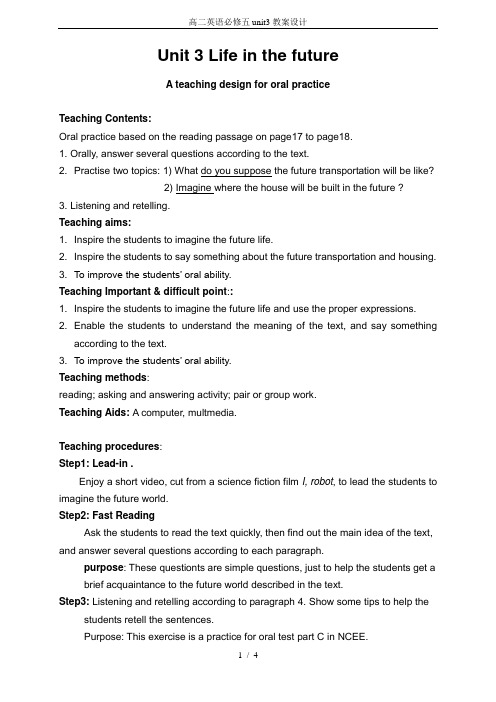
Unit 3 Life in the futureA teaching design for oral practiceTeaching Contents:Oral practice based on the reading passage on page17 to page18.1. Orally, answer several questions according to the text.2. Practise two topics:1) What do you suppose the future transportation will be like?2) Imagine where the house will be built in the future ?3. Listening and retelling.Teaching aims:1. Inspire the students to imagine the future life.2. Inspire the students to say something about the future transportation and housing.3. To improve the students’ oral ability.Teaching Important & difficult point::1. Inspire the students to imagine the future life and use the proper expressions.2. Enable the students to understand the meaning of the text, and say somethingaccording to the text.3. To improve the students’ oral ability.Teaching methods:reading; asking and answering activity; pair or group work.Teaching Aids: A computer, multmedia.Teaching procedures:Step1: Lead-in .Enjoy a short video, cut from a science fiction film I, robot, to lead the students to imagine the future world.Step2: Fast ReadingAsk the students to read the text quickly, then find out the main idea of the text, and answer several questions according to each paragraph.purpose: These questionts are simple questions, just to help the students get a brief acquaintance to the future world described in the text.Step3: Listening and retelling according to paragraph 4. Show some tips to help the students retell the sentences.Purpose: This exercise is a practice for oral test part C in NCEE.Step4: Design two topics while talking about the hovering carriage and Wang Ping’s house. Practise the dialogues of making predictions.Topic 1: What do you suppose the future transportation will be like?Topic 2: Imagine where the house will be built in the future ?The students may use these structures :I suppose the transportation will be something like a ….I suppose , in the future, the house will be built in…..I imagine that ….Purpose: To practise the structure orally I suppose that… , I imagine that.. . Step5: Summary of the text orally.This passage mainly tells us about a boy named Li Qiang”s trip to the future. It tells us how he got to the future, how he felt and what he had seen.Step6: Discussion.“What’s the writer’s attitude towards the future, optimistic or pessimistic?”“How do you know? “The students may begin like these :•In my opinion, the writer’s attitude towards the future is _________ .•As far as I am concerned, the writer feels _________ to the future.•I think the writer has an _________ view of the future.Purpose: To learn to analyze the writer’s attitude and express your conclusion. Step7 Homework1. To talk with your chairmate on the topic: Imagine, what the future world will be?2. Review the reading passage and find out the difficult language points to you.3. Finish exercises 1,2&4 on page 19.4. Review the words and phrases of this unit. A dictation tomorrow.Display on the blackboardUnit 3 Life in the Futurewh- do you suppose ….?I suppose …..I imagine that….And some words, perhaps they will be: science fiction film, high-tech, time tunnelPs: Display on the screenStep 1. Skimming:Skim through the passage and get its general idea.The passage is mainly about.A.how Li Qiang was transported to the future.B.how Li Qiang got to the future and his first impression of it.C.what the life was like in the future.D.the introduction of the “Future Tours ”company.1. What is a “time lag ”?“Time lag ’’is similar to the “jet lag ”. It means a person gets flashbacks from his previous time period.2.Who guides my trip?3. And who transported us to the future?Wang Ping ’s parents ’company transported us to the future.My friend Wang Ping is my guide to the future.1.How did I feel as soon as I wastransported to the future?I thought it was difficult to tolerate. I was hit by the lack of fresh air. 2. How did Wang Ping solve this problem?Wang Ping gave a mask to me and hurried me through to a small room nearby to have a rest.C. he felt a bit homesick.D. he was hit by a lack of fresh air.Hit by a lack of fresh air, my head ached.1. What did Wang Ping ’s house look like?large, bright and cleanHis house is a large bright, clean room.It had a green wall, a brown floor and soft lighting.Discussionpessimistic1.To talk with your chairmate on the topic:Imagine, what the future world will be?2.Review the reading passage and find outthe difficult language points to you.3.Finish exercises 1&2on page 19.4.Review the words and phrases of thisunit. A dictation tomorrow.Ten wordsfrom “lack”to “safety belt”.HomeworkThe Fifth Element.。
英语高二(上)人教版新课标必修(5)unit 3:同步教案(
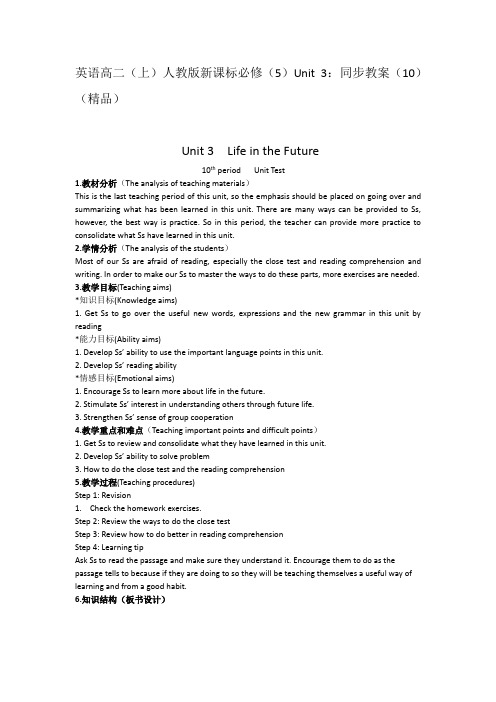
英语高二(上)人教版新课标必修(5)Unit 3:同步教案(10)(精品)Unit 3 Life in the Future10th period Unit Test1.教材分析(The analysis of teaching materials)This is the last teaching period of this unit, so the emphasis should be placed on going over and summarizing what has been learned in this unit. There are many ways can be provided to Ss, however, the best way is practice. So in this period, the teacher can provide more practice to consolidate what Ss have learned in this unit.2.学情分析(The analysis of the students)Most of our Ss are afraid of reading, especially the close test and reading comprehension and writing. In order to make our Ss to master the ways to do these parts, more exercises are needed.3.教学目标(Teaching aims)*知识目标(Knowledge aims)1. Get Ss to go over the useful new words, expressions and the new grammar in this unit by reading*能力目标(Ability aims)1. Develop Ss’ ability to use the important language points in this unit.2. Develop Ss’ reading ability*情感目标(Emotional aims)1. Encourage Ss to learn more about life in the future.2. Stimulate Ss’ interest in understanding others through future life.3. Strengthen Ss’ sense of group cooperation4.教学重点和难点(Teaching important points and difficult points)1. Get Ss to review and consolidate what they have learned in this unit.2. Develop Ss’ ability to solve problem3. How to do the close test and the reading comprehension5.教学过程(Teaching procedures)Step 1: Revision1.Check the homework exercises.Step 2: Review the ways to do the close testStep 3: Review how to do better in reading comprehensionStep 4: Learning tipAsk Ss to read the passage and make sure they understand it. Encourage them to do as the passage tells to because if they are doing to so they will be teaching themselves a useful way of learning and from a good habit.6.知识结构(板书设计)1.课堂提问(Questions)1) How can you know the answer?2) what is the key sentence of this passage or paragraph?3) How can we translate this sentence?2.练习和作业(Practice and homework)完形填空(A. B 层全做)阅读下面短文,掌握其大意,然后从各题所给的四个选项(A、B、C和D)中,选出最佳选项。
高二英语必修五unit3教案(完整资料)

Unit 3 Life in the futureA teaching design for oral practiceTeaching Contents:Oral practice based on the reading passage on page17 to page18.1. Orally, answer several questions according to the text.2. Practise two topics:1) What do you suppose the future transportation will be like?2) Imagine where the house will be built in the future ?3. Listening and retelling.Teaching aims:1. Inspire the students to imagine the future life.2. Inspire the students to say something about the future transportation and housing.3. To improve the students’ oral ability.Teaching Important & difficult point::1. Inspire the students to imagine the future life and use the proper expressions.2. Enable the students to understand the meaning of the text, and say somethingaccording to the text.3. To improve the students’ oral ability.Teaching methods:reading; asking and answering activity; pair or group work.Teaching Aids: A computer, multmedia.Teaching procedures:Step1: Lead-in .Enjoy a short video, cut from a science fiction film I, robot, to lead the students to imagine the future world.Step2: Fast ReadingAsk the students to read the text quickly, then find out the main idea of the text, and answer several questions according to each paragraph.purpose: These questionts are simple questions, just to help the students get a brief acquaintance to the future world described in the text.Step3: Listening and retelling according to paragraph 4. Show some tips to help the students retell the sentences.Purpose: This exercise is a practice for oral test part C in NCEE.Step4: Design two topics while talking about the hovering carriage and Wang Ping’s house. Practise the dialogues of making predictions.Topic 1: What do you suppose the future transportation will be like?Topic 2: Imagine where the house will be built in the future ?The students may use these structures :I suppose the transportation will be something like a ….I suppose , in the future, the house will be built in…..I imagine that ….Purpose: To practise the structure orally I suppose that… , I imagine that.. . Step5: Summary of the text orally.This passage mainly tells us about a boy named Li Qiang”s trip to the future. It tells us how he got to the future, how he felt and what he had seen.Step6: Discussion.“What’s the writer’s attitude towards the future, optimistic or pessimistic?”“How do you know? “The students may begin like these :•In my opinion, the writer’s attitude towards the future is _________ .•As far as I am concerned, the writer feels _________ to the future.•I think the writer has an _________ view of the future.Purpose: To learn to analyze the writer’s attitude and express your conclusion. Step7 Homework1. To talk with your chairmate on the topic: Imagine, what the future world will be?2. Review the reading passage and find out the difficult language points to you.3. Finish exercises 1,2&4 on page 19.4. Review the words and phrases of this unit. A dictation tomorrow.Display on the blackboardUnit 3 Life in the Futurewh- do you suppose ….?I suppose …..I imagine that….And some words, perhaps they will be: science fiction film, high-tech, time tunnelPs: Display on the screenStep 1. Skimming:Skim through the passage and get its general idea.The passage is mainly about.A.how Li Qiang was transported to the future.B.how Li Qiang got to the future and his first impression of it.C.what the life was like in the future.D.the introduction of the “Future Tours ”company.1. What is a “time lag ”?“Time lag ’’is similar to the “jet lag ”. It means a person gets flashbacks from his previous time period.2.Who guides my trip?3. And who transported us to the future?Wang Ping ’s parents ’company transported us to the future.My friend Wang Ping is my guide to the future.1.How did I feel as soon as I wastransported to the future?I thought it was difficult to tolerate. I was hit by the lack of fresh air. 2. How did Wang Ping solve this problem?Wang Ping gave a mask to me and hurried me through to a small room nearby to have a rest.C. he felt a bit homesick.D. he was hit by a lack of fresh air.Hit by a lack of fresh air, my head ached.1. What did Wang Ping ’s house look like?large, bright and cleanHis house is a large bright, clean room.It had a green wall, a brown floor and soft lighting.Discussionpessimistic1.To talk with your chairmate on the topic:Imagine, what the future world will be?2.Review the reading passage and find outthe difficult language points to you.3.Finish exercises 1&2on page 19.4.Review the words and phrases of thisunit. A dictation tomorrow.Ten wordsfrom “lack”to “safety belt”.HomeworkThe Fifth Element.。
英语高二(上)人教版新课标必修(5)unit3:同步教案(5)(精品)

英语高二(上)人教版新课标必修(5)Unit 3:同步教案(5)(精品)Unit 3 Life in the Future5th period reading (II) I have seen amazing things1.教材分析(the analysis of teaching materials)This Unit talks about life in the future. This passage mainly talks about a visit to a space station. With this background, the Ss can better cast a light on the future life.2.学情分析(the analysis of the students)From the first reading“First Impressions”, the Ss experience a wonderful future travel. With this basis, they can go on a further study about amazing things in the future life.3.教学目标(Teaching aims)*知识目标(Knowledge aims)1.Let the Ss understand the meanings of the new words as well as their usages.\2.Let the Ss know about some imaginary amazing things .*能力目标(Ability aims)1. Make the Ss to conclude the structure of the passage.*情感目标(Emotion aims)Through this passage, the Ss can open their mind to the space life, which can develop their imagination as well as a hope for the future life.4.教学重点和难点(teaching important points and difficult points)a. Help students extend the knowledge about future experience.b. Pronounce the new words correctly and know relative usages.5.教学过程(Teaching procedures)Step I: Pre-readingWhat does amazing mean? Do you know the amazing things?Step II: ReadingTask 1: Fast ReadingWhat is the shape of the space station? How many stops did I have?Task 2: Careful readingListen to the tape and try to fill in the form on p23. Step III: Words and expressions1.instant n.瞬间 in an instantadj.立即的一…就…the instant/instantly2.turn into变成turn in 上交turn up 出现,调高turn down 拒绝,调低turn out 结果是turn to 转向,向…求助3.副词/介词短语放句首+谓语+主语(名词非代词)e.g: Here comes the bus. Under the tree sits a boy.6.知识结构(板书设计)副板书:主板书:adj.立即的一…就…the instant/instantly2. turn into变成turn in 上交turn up 出现,调高turn down 拒绝,调低turn out 结果是turn to 转向,向…求助3.副词/介词短语放句首+谓语+主语(名词非代词)e.g: Here comes the bus. Under the tree sits a boy.7.问题研讨(课堂提问,练习和作业设计)1.课堂提问(questions)(1)What does amazing mean? Do you know the amazing things?(2 ) What is the shape of the space station? How many stops did I have?2.作业(homework)BC类:read the new words twice from citizen to motivation.ABC类:① You see the lightning ___ it happens, but you hear the thunder later.A. the instantB. for an instantC. on the instantD. in an instant② At the foot of the mountains _______.A. a village lieB. lies a villageC. does a village lieD. lying a village③当情况变得非常糟糕时,我向我的家人寻求帮助。
英语高二(上)人教版新课标必修(5)unit 3:同步教案((4)

英语高二(上)人教版新课标必修(5)Unit 3:同步教案(4)(精品)4th period Important language points(2)1.教材分析The emphasis of this period will be placed on the important new words, expressions and sentence patterns in this unit. In order to make students understand these important points thoroughly, we can first get students to understand their meanings in the context, then give some explanations about them, and later offer some practice to make students master their usage.2.学情分析Language points are the fundamental of learning English; however our students are all afraid of learning English, especially for some complicated language points.3.教学目标1.知识目标1). Get students to learn and grasp the important and useful new words and expressions in this part.2).Let students learn the following important and useful sentence patterns.2.能力目标1). Get studennts to use some useful new words and expressions correctly.2). Enable students to make sentences with the useful sentence patterns.4.教学重点1. Enable students to grasp the usage of such important new words and expressions as, impression ,take up,surrounding,lake, lose sight of ,sweep up, switch,constantly,be back on one's feet,fasten,slide into ,etc.2. Get students to master the patterns “The air seemed thin, as though its combination of gases had little oxygen left.”and “However, I lost my sight of Wang Peng when we reached what looked like a large market because of too many carriages flying by in all dircctions .”教学难点1.Let students learn the important of the words.2.2. Get students to understand some difficult and long sentences.5.教学过程*warm upStep 1 Revision1. Check the homework exercises.2. Ask some Ss to talk about body language.*presentation/practiceStep 2 Practice for useful words and expressions.1. Soon I was back on my feet again and following him to collect ahovering carriage driven by computer. 很快我又重新振作起来,跟随他领取了一部由电脑控制的气垫车.1)back on one's feet 经受打击后重新站起来,再次恢复了健康2)driven by computer在句中作定语,相当于which was driven by computer;过去分词短语作定语通常放在被修饰的词后面,相当于一个定语从句:The suggestion made by the foreign expert was adopted by the manager. 外国专家所提出的建议被经理采纳了。
人教高中英语必修五Unit3Lifeinthefuture教学设计

Life in the future教课方案Analysis of the teaching material教材剖析本单元教课内容为人教版Module 5 Unit 3 Life in the future 。
本单元的中心话题是“将来生活” ,教材内容为学生供给了想象的空间,旨在培育学生展望将来的能力,经过对现实生活与将来生活的对照,唤醒学生掌握此刻,珍惜此刻,爱惜环境,保护自然的意识。
Teaching goals 教课目的1. Target language 目口号言a.要点词汇和短语constantly, remind, vehicle, carriage, bathroom, temple, private, settlement, impression, constant, jet, previous, tablet, capsule, opening, surrounding, lack, ache,b.要点句式This is similar to ..., but it means ... P17Well- known for ..., his parents pany’,comalled “Future Tour”, transported me safely into the future in a time capsule.. P182. Ability goals 能力目标Enable the Ss to talk about the life in the past, at present and in the future.3. Learning ability goals 学能目标Help the Ss learn how to describe the life in the past, at present and in the future. Teaching important&difficult points教课重难点Compare life in the past, at present and in the future.What is life in the future like? What changes will take place?Teaching methods 教课方法Fast and careful reading; asking and answering activity; individual, group work. Teaching aids 教具准备A computer and a projector.Teaching procedures&ways教课过程与方式Step 1 Greetings and Lead-in1.The teacher can start with daily greetings and try to lead in some words in this unit.Q1: Where do you come from? Do you live in the downtown or in the countryside? 2.Q2: No matter where you live, I am wondering how do you usually go to school? 3.Now let’s take a look at the screen to learn about the development of all the means of transportation.4.Q3: What will the future means of transportation be like? (Time travel)【设计说明】由平时问候开启话题,经过发问学生展望将来,引出跨时空旅游,进而进入阅读文章的办理与学习。
人教新课标高中英语必修5Unit3Lifeinthefuture--period3教案
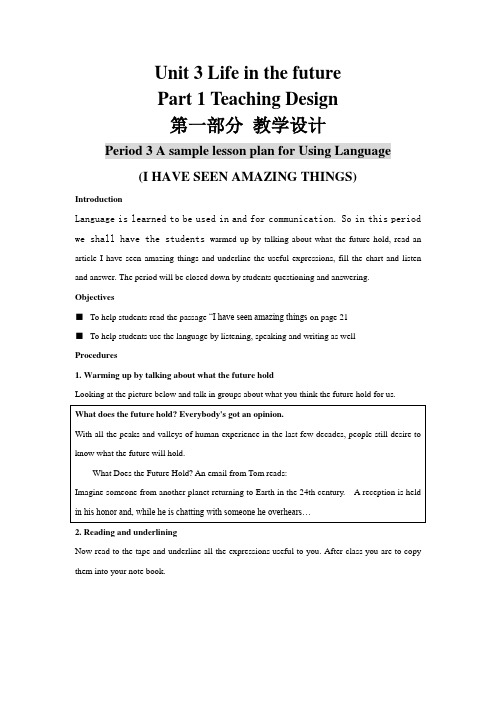
Unit 3 Life in the futurePart 1 Teaching Design第一部分教学设计Period 3 A sample lesson plan for Using Language(I HAVE SEEN AMAZING THINGS)IntroductionLanguage is learned to be used in and for communication. So in this period we shall have the students w armed up by talking about what the future hold, read an article I have seen amazing things and underline the useful expressions, fill the chart and listen and answer. The period will be closed down by students questioning and answering.Objectives■To help students read the passage “I have seen amazing things on page 21■To help students use the language by listening, speaking and writing as wellProcedures1. Warming up by talking about what the future holdLooking at the picture below and talk in groups about what you think the future hold for us.2. Reading and underliningNow read to the tape and underline all the expressions useful to you. After class you are to copy them into your note book.3. Filling the chartNext you are going to complete the worksheet on page 22 by writing identified details about the three items in the chart.Then use your imaginations to think up and talk about the best possible future life for yourselves.4. Listening and answeringI will play a tape about Wonderland to you and you are going to listen and answer the questions on page 23.5. Closing down by questioning and answeringIn pairs ask and answer questions about what life will be like in your country in 1000 years’ time. Use expressions like:。
(完整word版)高二英语人教版必修五Unit3教学设计教案
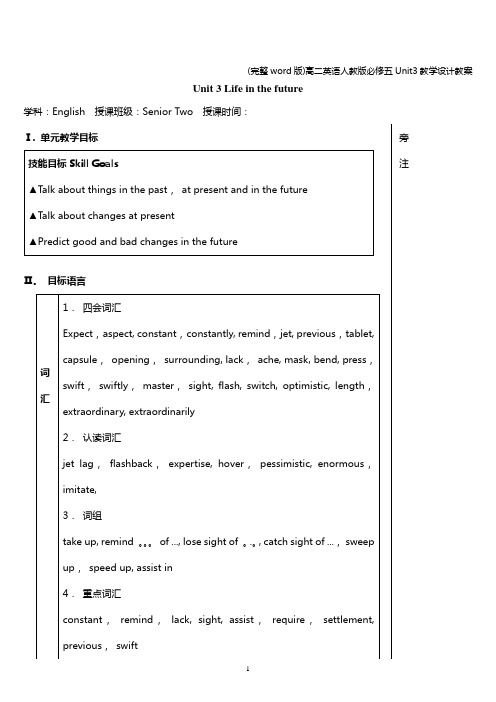
Unit 3 Life in the future 学科:English 授课班级:Senior Two 授课时间:Ⅰ. 单元教学目标Ⅱ。
目标语言旁注Ⅲ. 教材分析与教材重组1. 教材分析本单元以“Life in the future”为中心话题,旨在通过本单元的学习,让学生大胆发挥想象,对人类今后的生活环境,生活方式进行猜测,并在此基础上,对人类的种种活动进行反思,提倡环保生活意识.同时让学生学会过去分词作定语和作状语的不同用法。
最后让学生将本单元所讨论的话题和推测手法相结合,学习怎样写report。
1。
1 Warming Up 部分利用一个关于“住”和“行"的对比研究表格引导学生回顾过去,认识现在和展望未来。
通过这一活动,引发学生对过去,现在和未来的思考,使学生对将要阅读的文章有个知识准备。
1.2 Pre-reading 部分让学生充分运用发散思维,先列举当今世界人类面临的一些突出问题,然后要求学生思考为什么会产生这些问题,这些问题中哪些在未来社会仍然可能存在,哪些将会被克服,哪些将会恶化。
为下面的阅读做了铺垫。
1.3 Reading 部分通过一封发自未来的电子邮件,讲述了作者Li Qiang怎样安全到达“未来世界",他对“未来世界”的印象,以及“未来世界”的日常生活方式和交通工具情况.阅读时要把重点放在“未来世界”生活与当今生活的不同点上。
1。
4 Comprehending 部分设计了三个教学活动来加深学生对Reading部分的理解。
第一个活动要求学生通过阅读找出“未来世界"在以下几个方面的变化:跨时空旅行,交通,住房,城镇环境和空气质量.接着让学生在此基础上得出自己的结论,哪些变化好,哪些变化不好,并说明理由。
第二个活动要求学生通过阅读来判断Li Qiang对“未来世界”的态度是乐观的还是悲观的。
学生要在文中找出支持自己观点的论据,尽可能说服别人。
第三个活动让学生想象一下Li Qiang将会去参加哪些活动。
高中英语新人教必修五 Unit3 Life in the future单元教案
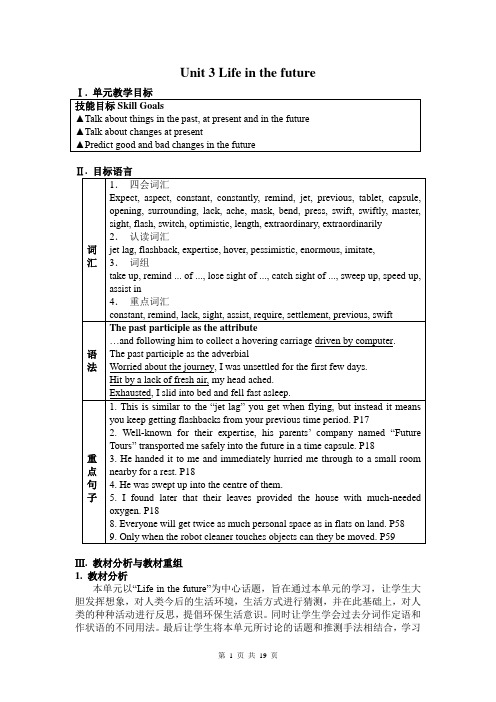
Unit 3 Life in the futureⅢ. 教材分析与教材重组1. 教材分析本单元以“Life in the future”为中心话题,旨在通过本单元的学习,让学生大胆发挥想象,对人类今后的生活环境,生活方式进行猜测,并在此基础上,对人类的种种活动进行反思,提倡环保生活意识。
同时让学生学会过去分词作定语和作状语的不同用法。
最后让学生将本单元所讨论的话题和推测手法相结合,学习怎样写report。
1.1 Warming Up 部分利用一个关于“住”和“行”的对比研究表格引导学生回顾过去,认识现在和展望未来。
通过这一活动,引发学生对过去,现在和未来的思考,使学生对将要阅读的文章有个知识准备。
1.2 Pre-reading 部分让学生充分运用发散思维,先列举当今世界人类面临的一些突出问题,然后要求学生思考为什么会产生这些问题,这些问题中哪些在未来社会仍然可能存在,哪些将会被克服,哪些将会恶化。
为下面的阅读做了铺垫。
1.3 Reading 部分通过一封发自未来的电子邮件,讲述了作者Li Qiang怎样安全到达“未来世界”,他对“未来世界”的印象,以及“未来世界”的日常生活方式和交通工具情况。
阅读时要把重点放在“未来世界”生活与当今生活的不同点上。
1.4 Comprehending 部分设计了三个教学活动来加深学生对Reading部分的理解。
第一个活动要求学生通过阅读找出“未来世界”在以下几个方面的变化:跨时空旅行,交通,住房,城镇环境和空气质量。
接着让学生在此基础上得出自己的结论,哪些变化好,哪些变化不好,并说明理由。
第二个活动要求学生通过阅读来判断Li Qiang对“未来世界”的态度是乐观的还是悲观的。
学生要在文中找出支持自己观点的论据,尽可能说服别人。
第三个活动让学生想象一下Li Qiang 将会去参加哪些活动。
这样既鼓励学生展开丰富的想象,又为Using Language 部分的语篇学习做了铺垫。
英语高二(上)人教版新课标必修(5)unit3:同步教案(2)(精品)
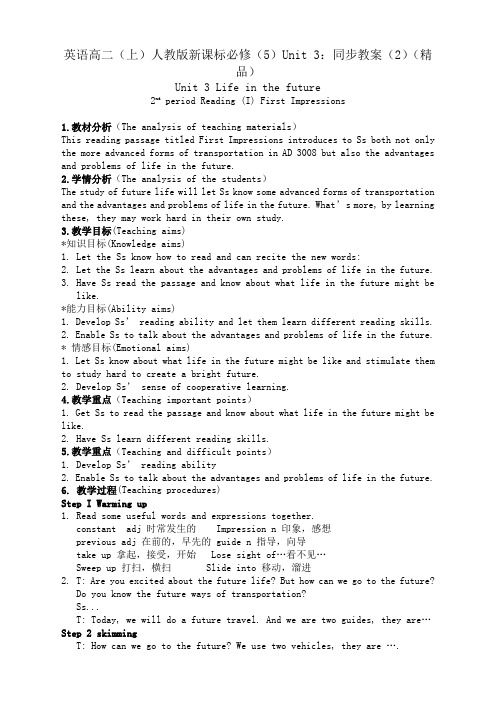
英语高二(上)人教版新课标必修(5)Unit 3:同步教案(2)(精品)Unit 3 Life in the future2nd period Reading (I) First Impressions1.教材分析(The analysis of teaching materials)This reading passage titled First Impressions introduces to Ss both not only the more advanced forms of transportation in AD 3008 but also the advantages and problems of life in the future.2.学情分析(The analysis of the students)The study of future life will let Ss know some advanced forms of transportation and the advantages and problems of life in the future. What’s more, by learning these, they may work hard in their own study.3.教学目标(Teaching aims)*知识目标(Knowledge aims)1.Let the Ss know how to read and can recite the new words:2.Let the Ss learn about the advantages and problems of life in the future.3.Have Ss read the passage and know about what life in the future might belike.*能力目标(Ability aims)1. Develop Ss’ reading ability and let them learn different reading skills.2. Enable Ss to talk about the advantages and problems of life in the future. * 情感目标(Emotional aims)1. Let Ss know about what life in the future might be like and stimulate them to study hard to create a bright future.2. Develop Ss’ sense of cooperative learning.4.教学重点(Teaching important points)1. Get Ss to read the passage and know about what life in the future might be like.2. Have Ss learn different reading skills.5.教学重点(Teaching and difficult points)1. Develop Ss’ reading ability2. Enable Ss to talk about the advantages and problems of life in the future.6. 教学过程(Teaching procedures)Step I Warming up1.Read some useful words and expressions together.constant adj 时常发生的 Impression n 印象,感想previous adj 在前的,早先的 guide n 指导,向导take up 拿起,接受,开始 Lose sight of…看不见…Sweep up 打扫,横扫 Slide into 移动,溜进2.T: Are you excited about the future life? But how can we go to the future?Do you know the future ways of transportation?Ss...T: Today, we will do a future travel. And we are two guides, they are…Step 2 skimmingT: How can we go to the future? We use two vehicles, they are ….Ss: time capsule, a hovering carriage.Step 3 Detailed reading1.Now let’s begin our journey, so before the journey, what would happen?1). Listen to paragraph 1.2). Answer the following questions①. Why can Li Qiang go to thw future?②. How about his feelings?③ Did he have any problem?④. What was his feeling?⑤. How did he overcome it?2. What would happen during the journey?1). Listen to paragraph 22). Answer the following questions① Look at the picture, what were they doing?② Inside the capsule, there were some seats. They were comfortable.③ What’s this? It’s a drink. It’s a drink for calming.④ After the drinkm, Li Qiang was sleepy. At the same time, the capsule swung gently sideways.3. What would life be like in the future? So we walked out of the capsule. This is the world in 1000 years.1). Listen to Paragraph 3.2). Answer the following questions.① Did he have any problem?why?② Then how to overcome it?③ How to use the hovering carriage swiftly?3) In a large market① What were people doing there?② What problem did Li Qiang have?③ Where was Wang Ping?3.After the journey1). Listen to paragraph 42). Answer the following questions.① What’s the description of Wang Ping’s home?Step 4 SummaryLi Qiang was in the AD 3008, he felt very lonely, and he missed his mother very much. So he made a call. Use the questions to make a dialogue. Now work in pairs. One is Li Qiang and the other is his mother.1.Questions:L: Mom, this is Li. I have traveled to the year AD 3008.M: Really, how did you go there?L: …M: Who went with you?L: …M: What have you seen?L: …M: How do you feel?L: …M: When will you come back?...Step5 Design a future school.1.Enjoy a video about Jimmy’s future life.2.Try to design a future school for Jimmy.3.Invite one of Ss come to draw a picture on the blackboard.Step 6 Discussion1.How to create a wonderful feature?2.Studying hard creates a better future.7.知识结构(板书设计)8.问题研讨(课堂提问,练习和作业设计)1.课堂提问(questions)1). How can we go to the future?2) What would the future life be like?2.练习(practice)Read the new words3作业(homework)A level:Finish exercise 3 “Learning about language” on P20.3. complete this advertisement choosing words or phrases in their proper forms.Need space cooks , cleaners , teachers , stewards and __________. You can be swiftly trained for your new job from using _________ skills. At first people may find the _________ to space life difficult to __________. However, they will be able to overcome the difficulties if their families encourage them to ____________ the job. That is why we persuade families not to ___________the advantages that come from a period of time in space. For health reasons only one stay of three years is allowed. People often want to stay longer, but the __________ between illness and length of stay is strong. It is sad, but the rules cannot be __________ for anyone.Key: opportunities, constantly, stewardesses, previous, adjustment, tolerate, take up, lose sight of, link, bentA /B level:Finish exercise 2 “Learning about language” on P20.2. Combine a verb from the left box with a word from the right box. Write down1.Where on earth did I put my belt? I am constantly losing it and having to______it.2.When we flew in the space capsule we were _______into the sky sp quicklythat I did not even have time to fasten my safety belt.3.When we wanted the hovering carriage to speed up, we ________ hard on thedriving pedal and bent over in the direction we wanted to go.4.After having your dinner, you __________ all the rubbish on the floor. Letthe net group of people have pleasant surrounding to eat it.5.After he won the competition, Li Qiang ___________ his prize and went ona time tour with his friend and guide Wang Ping.6.The steward opened the door of the spaceship and Li Qiang _________sideways______his seats.Key: 1. search for 2. swept up 3. pressed down 4. sweep up 5. took up 6. slid intoA/B/ C level:Review the new words of the passage and get ready for the dictation.constant adj 时常发生的 Impression n 印象,感想previous adj 在前的,早先的 guide n 指导,向导take up 拿起,接受,开始 Lose sight of…看不见…Sweep up 打扫,横扫 Slide into 移动,溜进。
高二英语 必修5 unit3 教学设计
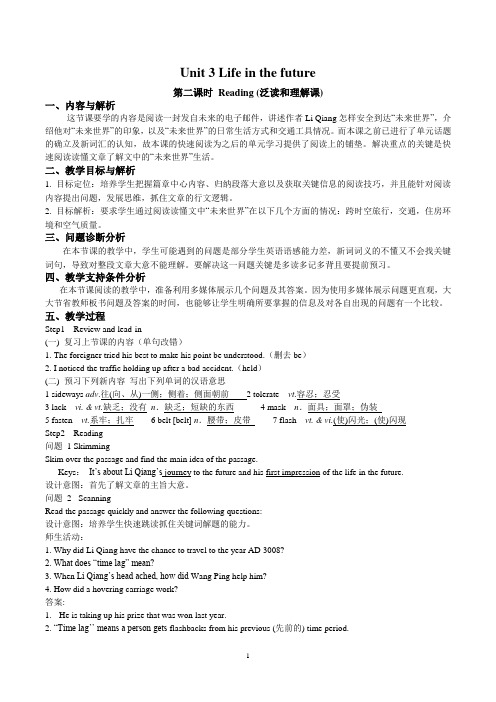
Unit 3 Life in the future第二课时Reading (泛读和理解课)一、内容与解析这节课要学的内容是阅读一封发自未来的电子邮件,讲述作者Li Qiang怎样安全到达―未来世界‖,介绍他对―未来世界‖的印象,以及―未来世界‖的日常生活方式和交通工具情况。
而本课之前已进行了单元话题的确立及新词汇的认知,故本课的快速阅读为之后的单元学习提供了阅读上的铺垫。
解决重点的关键是快速阅读读懂文章了解文中的―未来世界‖生活。
二、教学目标与解析1. 目标定位:培养学生把握篇章中心内容、归纳段落大意以及获取关键信息的阅读技巧,并且能针对阅读内容提出问题,发展思维,抓住文章的行文逻辑。
2. 目标解析:要求学生通过阅读读懂文中―未来世界‖在以下几个方面的情况:跨时空旅行,交通,住房环境和空气质量。
三、问题诊断分析在本节课的教学中,学生可能遇到的问题是部分学生英语语感能力差,新词词义的不懂又不会找关键词句,导致对整段文章大意不能理解。
要解决这一问题关键是多读多记多背且要提前预习。
四、教学支持条件分析在本节课阅读的教学中,准备利用多媒体展示几个问题及其答案。
因为使用多媒体展示问题更直观,大大节省教师板书问题及答案的时间,也能够让学生明确所要掌握的信息及对各自出现的问题有一个比较。
五、教学过程Step1 Review and lead-in(一) 复习上节课的内容(单句改错)1. The foreigner tried his best to make his point be understood.(删去be)2. I noticed the traffic holding up after a bad accident.(held)(二) 预习下列新内容写出下列单词的汉语意思1 sideways adv.往(向、从)一侧;侧着;侧面朝前2 tolerate vt.容忍;忍受3 lack vi. & vt.缺乏;没有n.缺乏;短缺的东西4 mask n.面具;面罩;伪装5 fasten vt.系牢;扎牢6 belt [belt] n.腰带;皮带7 flash vt. & vi.(使)闪光;(使)闪现Step2 Reading问题 1 SkimmingSkim over the passage and find the main idea of the passage.Keys:It’s about Li Qiang’s journey to the future and his first impression of the life in the future.设计意图:首先了解文章的主旨大意。
高二英语必修五unit3教案复习课程
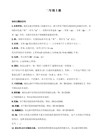
联系网站删除
Unit 3 Life in the future A teaching design for oral practice Teaching Contents: Oral practice based on the reading passage on page17 to page18. 1. Orally, answer several questions according to the text. 2. Practise two topics: 1) What do you suppose the future transportation will be like? 2) Imagine where the house will be built in the future ? 3. Listening and retelling. Teaching aims: 1. Inspire the students to imagine the future life. 2. Inspire the students to say something about the future transportation and housing. 3. To improve the students’ oral ability. Teaching Important & difficult point:: 1. Inspire the students to imagine the future life and use the proper expressions. 2. Enable the students to understand the meaning of the text, and say something according to the text. 3. To improve the students’ oral ability. Teaching methring activity; pair or group work. Teaching Aids: A computer, multmedia. Teaching procedures: Step1: Lead-in . Enjoy a short video, cut from a science fiction film I, robot, to lead the students to imagine the future world. Step2: Fast Reading Ask the students to read the text quickly, then find out the main idea of the text, and answer several questions according to each paragraph. purpose: These questionts are simple questions, just to help the students get a brief acquaintance to the future world described in the text. Step3: Listening and retelling according to paragraph 4. Show some tips to help the students retell the sentences. Purpose: This exercise is a practice for oral test part C in NCEE.
高中英语新人教必修五 Unit3 Life in the future单元教案

Unit 3 Life in the futureⅢ. 教材分析与教材重组1. 教材分析本单元以“Life in the future”为中心话题,旨在通过本单元的学习,让学生大胆发挥想象,对人类今后的生活环境,生活方式进行猜测,并在此基础上,对人类的种种活动进行反思,提倡环保生活意识。
同时让学生学会过去分词作定语和作状语的不同用法。
最后让学生将本单元所讨论的话题和推测手法相结合,学习怎样写report。
1.1 Warming Up 部分利用一个关于“住”和“行”的对比研究表格引导学生回顾过去,认识现在和展望未来。
通过这一活动,引发学生对过去,现在和未来的思考,使学生对将要阅读的文章有个知识准备。
1.2 Pre-reading 部分让学生充分运用发散思维,先列举当今世界人类面临的一些突出问题,然后要求学生思考为什么会产生这些问题,这些问题中哪些在未来社会仍然可能存在,哪些将会被克服,哪些将会恶化。
为下面的阅读做了铺垫。
1.3 Reading 部分通过一封发自未来的电子邮件,讲述了作者Li Qiang怎样安全到达“未来世界”,他对“未来世界”的印象,以及“未来世界”的日常生活方式和交通工具情况。
阅读时要把重点放在“未来世界”生活与当今生活的不同点上。
1.4 Comprehending 部分设计了三个教学活动来加深学生对Reading部分的理解。
第一个活动要求学生通过阅读找出“未来世界”在以下几个方面的变化:跨时空旅行,交通,住房,城镇环境和空气质量。
接着让学生在此基础上得出自己的结论,哪些变化好,哪些变化不好,并说明理由。
第二个活动要求学生通过阅读来判断Li Qiang对“未来世界”的态度是乐观的还是悲观的。
学生要在文中找出支持自己观点的论据,尽可能说服别人。
第三个活动让学生想象一下Li Qiang 将会去参加哪些活动。
这样既鼓励学生展开丰富的想象,又为Using Language 部分的语篇学习做了铺垫。
高中英语人教版必修5unit3LifeinthefutureUsinglanguage教案..
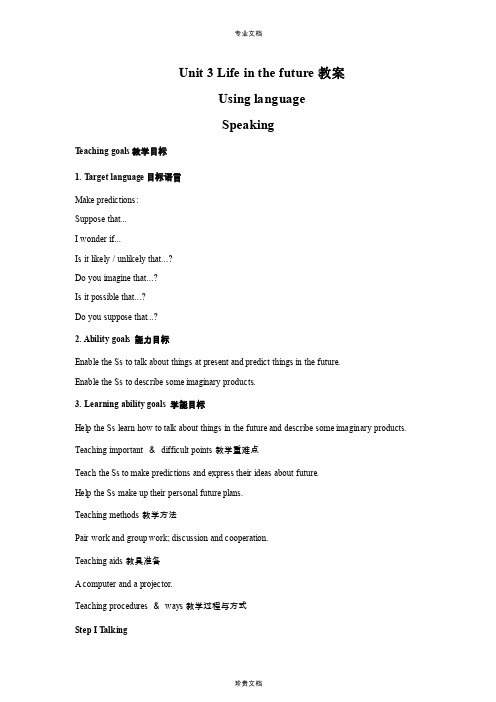
Unit 3 Life in the future教案Using languageSpeakingT eaching goals教学目标1. T arget language目标语言Make predictions:Suppose that...I wonder if...Is it likely / unlikely that...?Do you imagine that...?Is it possible that...?Do you suppose that...?2. Ability goals 能力目标Enable the Ss to talk about things at present and predict things in the future.Enable the Ss to describe some imaginary products.3. Learning ability goals 学能目标Help the Ss learn how to talk about things in the future and describe some imaginary products. Teaching important &difficult points教学重难点Teach the Ss to make predictions and express their ideas about future.Help the Ss make up their personal future plans.Teaching methods教学方法Pair work and group work; discussion and cooperation.Teaching aids教具准备A computer and a projector.Teaching procedures &ways教学过程与方式Step I T alkingSet a scene for the Ss: A man who is living in AD 2046 comes to visit your city and wants to know something about jobs in your city. Ask the Ss to work in pairs to make out an introduction plan. Make a comparison between jobs at present and jobs in the future, and find out the changes and why these changes take place.T: In the first period of our unit, we discussed the changes between life in the past and life at present, also we make a prediction about our future, right? Today let’s still talk about the future. Suppose a man of AD 2046 comes to our city, he wants to know something about jobs in our city. How will you introduce the following two kinds of jobs to him? Teachers and farmers.Give the Ss 1-2 minutes to discuss and then ask some of them to represent their opinions.T: OK. Who would like to talk about the job as a farmer?S: Nowadays farmers are still working very hard. Few of them use hi-tech machines, especially in developing countries. They have to work most by hand everyday. Sometimes they will use some machines such as trucks, seeding-machines, etc. In developed countries, agriculture has been computerized. Farmers in those countries are much easier.T: Good. What about teachers?S: Nowadays lots of students stay in the classrooms to listen to their teachers. And the teachers have to use chalk, and sometimes they use computers.Set another scene.T: So it seems that both these two kinds of jobs are very challenging. Will they change in the future? Now the man invites you to his city in the year 2046, what changes will you expect to find on these two jobs?S: I think 40 years later, working as a farmer will be much easier than now. Farmers won’t have to work by hand, they can set a program in the computer and then the computer will finish all the tasks. It’s fantastic! And the harvest will be much better because of the science.S: I think in the future we don’t have to come to school to study. Teache rs will work on the Internet. We will have classes through the Internet. And unlike today’s teacher, in the future, a teacher can teach many subjects. And we will have robots do teaching jobs.T: So maybe I should be born 40 years later, in that case, the job for me will be much interesting. Step II Follow-up ActivityEncourage the Ss to predict their future life and make a short-term plan. Let them talk about theirdreams and then write passages introducing these dreams.T: Everyone, have you ever dreamt of your own future? Have you asked yourself what you will be? Now let’s make a prediction, or we can say, let’s make a plan for ourselves: What will I be in the future? Y ou can discuss with your partners to fill in the following chart and then write a pas sage introducing your dreams.Show the Ss the chart on the screen.Give the Ss enough time to discuss. This will help them make clear of their own future. And then select some Ss to give a report to the whole class.Step Ⅳ HomeworkT: Imagine you are at your age of 30. Write a passage to describe your daily life or your experience.A sample version:It is the year 2020 and I have just turned 30 years old. More than 10 years ago, I left high school and went to study at a good university. I was a history major and I also studied two foreign languages. After graduation, I was offered a job teaching history in a middle school. At first, I didn’t think I’d like to teach history. I thought the students would think history w as too boring. My first year was very difficult. I didn’t know much about teaching and the students did not like my lessons. But I was lucky. One of the older teachers became my friend and taught me a lot.。
- 1、下载文档前请自行甄别文档内容的完整性,平台不提供额外的编辑、内容补充、找答案等附加服务。
- 2、"仅部分预览"的文档,不可在线预览部分如存在完整性等问题,可反馈申请退款(可完整预览的文档不适用该条件!)。
- 3、如文档侵犯您的权益,请联系客服反馈,我们会尽快为您处理(人工客服工作时间:9:00-18:30)。
Unit 3 Life in the futureA teaching design for oral practiceTeaching Contents:Oral practice based on the reading passage on page17 to page18.1. Orally, answer several questions according to the text.2. Practise two topics:1) What do you suppose the future transportation will be like?2) Imagine where the house will be built in the future ?3. Listening and retelling.Teaching aims:1. Inspire the students to imagine the future life.2. Inspire the students to say something about the future transportation and housing.3. To improve the students’ oral ability.Teaching Important & difficult point::1. Inspire the students to imagine the future life and use the proper expressions.2. Enable the students to understand the meaning of the text, and say somethingaccording to the text.3. To improve the students’ oral ability.Teaching methods:reading; asking and answering activity; pair or group work.Teaching Aids: A computer, multmedia.Teaching procedures:Step1: Lead-in .Enjoy a short video, cut from a science fiction film I, robot, to lead the students to imagine the future world.Step2: Fast ReadingAsk the students to read the text quickly, then find out the main idea of the text, and answer several questions according to each paragraph.purpose: These questionts are simple questions, just to help the students get a brief acquaintance to the future world described in the text.Step3: Listening and retelling according to paragraph 4. Show some tips to help the students retell the sentences.Purpose: This exercise is a practice for oral test part C in NCEE.Step4: Design two topics while talking about the hovering carriage and Wang Ping’s house. Practise the dialogues of making predictions.Topic 1: What do you suppose the future transportation will be like?Topic 2: Imagine where the house will be built in the future ?The students may use these structures :I suppose the transportation will be something like a ….I suppose , in the future, the house will be built in…..I imagine that ….Purpose: To practise the structure orally I suppose that… , I imagine that.. . Step5: Summary of the text orally.This passage mainly tells us about a boy named Li Qiang”s trip to the future. It tells us how he got to the future, how he felt and what he had seen.Step6: Discussion.“What’s the writer’s attitude towards the future, optimistic or pessimistic?”“How do you know? “The students may begin like these :•In my opinion, the writer’s attitude towards the future is _________ .•As far as I am concerned, the writer feels _________ to the future.•I think the writer has an _________ view of the future.Purpose: To learn to analyze the writer’s attitude and express your conclusion. Step7 Homework1. To talk with your chairmate on the topic: Imagine, what the future world will be?2. Review the reading passage and find out the difficult language points to you.3. Finish exercises 1,2&4 on page 19.4. Review the words and phrases of this unit. A dictation tomorrow.Display on the blackboardUnit 3 Life in the Futurewh- do you suppose ….?I suppose …..I imagine that….And some words, perhaps they will be: science fiction film, high-tech, time tunnelPs: Display on the screenStep 1. Skimming:Skim through the passage and get its general idea.The passage is mainly about.A.how Li Qiang was transported to the future.B.how Li Qiang got to the future and his first impression of it.C.what the life was like in the future.D.the introduction of the “Future Tours ”company.1. What is a “time lag ”?“Time lag ’’is similar to the “jet lag ”. It means a person gets flashbacks from his previous time period.2.Who guides my trip?3. And who transported us to the future?Wang Ping ’s parents ’company transported us to the future.My friend Wang Ping is my guide to the future.1.How did I feel as soon as I wastransported to the future?I thought it was difficult to tolerate. I was hit by the lack of fresh air. 2. How did Wang Ping solve this problem?Wang Ping gave a mask to me and hurried me through to a small room nearby to have a rest.C. he felt a bit homesick.D. he was hit by a lack of fresh air.Hit by a lack of fresh air, my head ached.1. What did Wang Ping ’s house look like?large, bright and cleanHis house is a large bright, clean room.It had a green wall, a brown floor and soft lighting.Discussionpessimistic1.To talk with your chairmate on the topic:Imagine, what the future world will be?2.Review the reading passage and find outthe difficult language points to you.3.Finish exercises 1&2on page 19.4.Review the words and phrases of thisunit. A dictation tomorrow.Ten wordsfrom “lack”to “safety belt”.HomeworkThe Fifth Element.。
